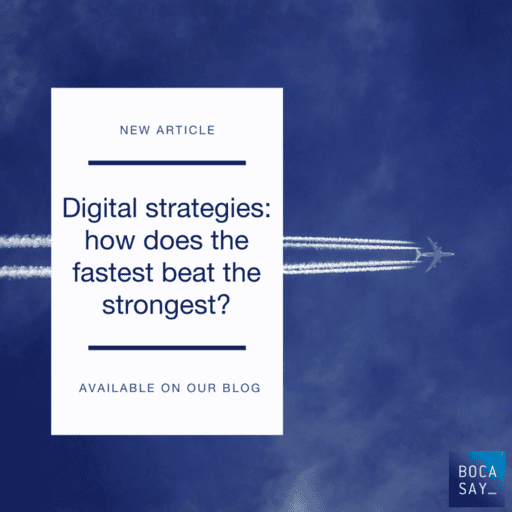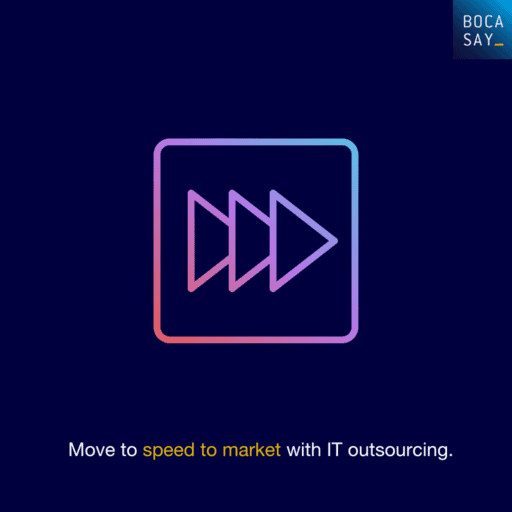Digital Strategies: How Does The Fastest Beat The Strongest?
In our highly competitive times, it’s all about who manages to reach the market first. In this article, we focus on Speed to Market, which is Time to Market’s successor. In addition, as a way of beating your competitors, we showcase helpful digital strategy approaches like Pareto’s law, Test & Learn and DevOps.
“The strong will no longer beat the weak. From now on, it will be the fast that beats the slow” Rupert Murdoch, Australian-American businessman, media magnate and billionaire.
During the last decades, successful individuals and companies have tended to ride the wave of Speed to Market rather than Time to Market.
Speed to Market refers to getting products on the shelves as quickly as possible. Consumers should be able to find your final products everywhere, either in physical stores or online, and often simultaneously within both.

Time to Market is the time that elapses between the development of an offer/product and its implementation on the market. A Time to Market that takes too long will usually have negative consequences on the company’s commercial objectives.
Moderna, an exemplary company for Speed to Market implementation
The American biotech company Moderna is a company that utilizes digital technologies like Artificial Intelligence (AI) during all stages of its processes.
This Cambridge-based company took only 65 days between learning the genetic sequence of the Covid-19 virus and the first test-injection on a human being. This type of lightning speed is unprecedented within an industry where product-cycles usually take years.
This strategy, entirely based on speed, was made possible through the automation of information flows and the use of Artificial Intelligence, a subject Moderna has mastered extremely well since its creation in 2010. In addition, Moderna’s entire digital infrastructure is cloud-based.
How do we transition from Time to Market to Speed to Market?
While prioritizing the quality of the product or service being sold, the philosophy behind Time to Market indicates the necessary duration between product development and its subsequent market availability. Within the Time to Market approach, the notion of quality present and crucial.
However, when we delve into the Speed to Market approach, the notion of “quality” loses some of its importance. It goes without saying that producing high quality software in a very short time is almost impossible. Speed to Market means that the most important thing is to be the first to reach your market at any cost.
Speed strategies have always existed within ultra-competitive markets and today they are more essential than ever before.
ℝ𝕖𝕞𝕒𝕚𝕟 𝕝𝕖𝕒𝕕𝕖𝕣 𝕚𝕟 𝕪𝕠𝕦𝕣 𝕤𝕖𝕔𝕥𝕠𝕣 𝕨𝕚𝕥𝕙 𝔹𝕠𝕔𝕒𝕤𝕒𝕪! 𝕆𝕦𝕣 𝕠𝕗𝕗𝕤𝕙𝕠𝕣𝕖 𝕨𝕖𝕓 𝕕𝕖𝕧𝕖𝕝𝕠𝕡𝕞𝕖𝕟𝕥 𝕔𝕖𝕟𝕥𝕖𝕣 𝕤𝕦𝕡𝕡𝕠𝕣𝕥𝕤 𝕪𝕠𝕦 𝕚𝕟 𝕒𝕝𝕝 𝕪𝕠𝕦𝕣 𝕕𝕚𝕘𝕚𝕥𝕒𝕝 𝕡𝕣𝕠𝕛𝕖𝕔𝕥𝕤! ℂ𝕠𝕟𝕥𝕒𝕔𝕥 𝕦𝕤 𝕟𝕠𝕨 𝕥𝕠 𝕘𝕖𝕥 𝕪𝕠𝕦𝕣 𝕗𝕣𝕖𝕖 𝕢𝕦𝕠𝕥𝕖!
As a decision-maker, you often have a short time-frame in order to take the best decisions possible. Wondering how lightning-fast, informed decisions are taken? Here is the short answer: They rely on data. Yes, this is exactly where the data-driven strategy comes into its own. Without useful data, it is either very difficult or impossible to make smart decisions within a short period of time.
A data driven strategy refers to a set of actions that will collect, collate, structure, analyze and especially interpret data. The objective is to make informed decisions, based on a deep understanding of data that guides a company’s marketing and sales strategies.
Here are some other fundamental principles that contribute to prioritizing the factor of “time”:
- The test & learn principle.
- The DevOps philosophy.
- The Pareto principle.
The Test & Learn Approach
Test & Learn is a state of mind that consists of launching a new software on the market as quickly as possible in the form of a prototype, or an unfinished application.
The objective is to experiment with short cycles in order to optimize and readjust the software’s functionalities according to results obtained and users’ feedback. We start from the principle that we learn from our mistakes, and this is exactly what is implemented within the Test & Learn approach. A company uses feedback to refine its software, improving everything as best as possible.

The DevOps Philosophy
DevOps is a combo-term that entails development and operations. This mindset focuses on automating the development and maintenance of IT systems. Though this approach, both the quality and the delivery time to the users are considerably reduced. This is achieved by merging the development teams with the quality and operations teams. All these teams form a single unit and are no longer siloed to work in their own corners. The DevOps approach helps companies to work closer to the concept of Speed to Market, as it offers the following business benefits:
- Acceleration of application production.
- Improved quality of development and operations.
- Faster reactivity and updates according to end-users’ needs.
The 80-20 law, also known as Pareto’s law
Vilfredo Pareto was an Italian economist who worked on tax data from several countries including England, France, Italy, Prussia, Switzerland… He observed a similar phenomenon in every country: the percentage of the population that holds wealth greater than a value x is always proportional to A/xα, the coefficient α varies from country to country. This is how the Pareto principle was born.
Pareto’s law states that 80% of the effects come from only 20% of the causes.
Here are some real-world examples of application:
- Within SEO (search engine optimization), we can say that 20% of the visitors of a website arrived from the main keywords.
- 80% of the turnover is made by 20% of the customers.
- 80% of customer complaints come from 20% of products or 20% of customers.
- And so on.
Pareto’s law is very interesting in the sense that it will push individuals to focus on the essential, to simplify things, and to move forward with more efficient actions.
This brings us to the last part of our article: practicing extreme simplification.
The easier it is, the more beautiful it is
“The easier it is, the more beautiful it is”. This is the title of a book by the artist Eric Watier, born in Bayonne and currently working in Montpellier. This sentence was hijacked on the web and transformed into: “The simpler it is, the more beautiful it is”. This statement also refers to another contemporary art trend: minimalism.
More and more startups are focusing on simple processes and will delegate the intermediate steps to other organizations in order to focus on their core goals and reach their end-result more easily.
Let’s take the example of Amazon and its almost non-existent customer service. The American e-commerce giant focuses all its efforts on making order management and shipping processes as “simple” as possible for customers to use. This makes it possible to “do without” customer service in most cases. The ease of ordering on the Amazon website proves to what extent focusing on a specific process, already allows to reach 80% of its objectives.
Reference: The new horizon of digital transformation by Pejman Gohari